
In last week’s article, I mentioned that the fourth incarnation of the Masters of Evil, the most brutal and infamous of the various versions, was later reformed by leader Helmut Zemo as the Thunderbolts. You might ask, “How can this be? I thought the Thunderbolts were good guys. What gives?” As usual, the answer is a little more complicated than that. They are good guys, and yet they aren’t—or rather, weren’t. You see, back in the beginning, the team was going to be another rehash of the old-hat Masters of Evil, but then Zemo had this idea. The Avengers and the Fantastic Four were dead, and so . . . wait, you mean you hadn’t heard?
Let’s back up a little and shed some light on a particularly . . . interesting . . . era in Marvel comics, when they destroyed their two favorite teams and recreated them anew. This was the era of Heroes Reborn!
AN ABSOLUTE ONSLAUGHT
It began when the X-Men sent a contingent to the Avalon Space Station to try and apprehend Magneto, who had just obliterated the entire world’s power system with an electro-magnetic pulse. With the help of Colossus, who was one of Magneto’s acolytes at the time, a small group of X-Men snuck aboard the space station and tried to ambush Magneto. It was during the “Fatal Attractions” story arc, with Wolverine just about to claw the life out of Magneto, that Magneto literally ripped the adamantium out of Wolverine’s bones*. In retaliation, and in a rare moment where he caved in to emotion and rage, Professor X used his power to literally wipe Magneto’s mind clean.
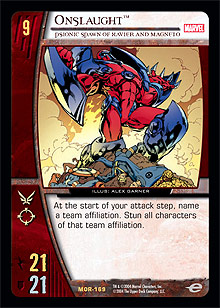 Unfortunately, life never works out the way we’d expect it to, and Magneto essentially rode the mind wave, sending a little piece of his psyche into the Professor’s mind in a psionic backlash. That little psychic fragment fed on Professor X’s brain and spawned a sentient psionic being, which would form a physical body for itself and be known as Onslaught.
Unfortunately, life never works out the way we’d expect it to, and Magneto essentially rode the mind wave, sending a little piece of his psyche into the Professor’s mind in a psionic backlash. That little psychic fragment fed on Professor X’s brain and spawned a sentient psionic being, which would form a physical body for itself and be known as Onslaught.
Onslaught was big. He was bad. He was immensely powerful, having all of the powers and intellect of both Professor X and Magneto—and still more. It took the Avengers, the Fantastic Four, the X-Men, Hulk, and Dr. Doom all working together to beat him, which is why his card, a measly 21 ATK/21 DEF 9-drop, can stun entire teams.
It was thought that the Avengers, Fantastic Four, and Dr. Doom all died fighting Onslaught—but, in fact, young Franklin Richards saved them all, creating an alternate reality where the heroes were “reborn” with no memory of Earth and slightly alternate pasts. They would eventually return to their proper reality, but while they were gone, the world mourned the loss of so many of its heroes. Others took advantage of the loss by taking their places.
INTRODUCTION: THE THUNDERBOLTS!
What happens when an evil mastermind prepares to gather his villainous allies to once again attempt to vanquish his mortal enemies, only to find out that those enemies are already vanquished? Why, he takes their place. Enter the Thunderbolts!
Helmut Zemo saw a chance to do much more than simply take advantage of the loss of the heroic teams to rob and pillage such as many other villains did. Oh, no, that would be far too easy. Zemo felt that it would be an even greater triumph to work from the inside out. How much better would it be to gain the trust of the common people as their new “heroes,” and use that blind faith to turn around and conquer the world!
Zemo set out to put together a team that would be able to cunningly assume the guise of heroes with the intention of taking advantage of any misplaced loyalty. He also wanted a team that he could control and whose loyalty he could count on. He first brought the Fixer into the fold, renaming him Techno. This was because the Fixer’s technical knowledge and skill at invention would be invaluable to the team, both regarding weaponry and gadgetry and in finding ways to help the team keep their current and former identities separate.
Zemo’s next recruit—and perhaps his most important—was the Beetle. Abner Jenkins, also known as the Beetle, had been going from one failed crime to another. He was desperate for leadership and acceptance. With the Fixer’s help, he created the Mobile Armored Cyber Harness, or MACH, armor, and called himself MACH-1. The number would rise with each subsequent, modified set of armor or when he switched identities—more on that later.
Next on the list was Screaming Mimi. Her lover and partner in crime, Angar the Screamer, had just been shot to death in a failed bank robbery, and she had screamed her vocal cords to little pieces. Zemo offered her a chance to heal up and a safe haven, which she gratefully accepted. The Fixer fixed her up with a special sonic harness that increased her powers without taxing her heavily damaged vocal cords. She changed her name to Songbird and became a loyal member of the team.
Next, Zemo and the Fixer turned their attention to Erik Josten, the Goliath who had fought alongside them against the Avengers in the fourth incarnation of the Masters of Evil. Josten had since been stranded in the Kosmos dimension, where he was constantly under attack by the insectoid creatures that lived there. Zemo rescued him, and Josten pledged a fierce loyalty to him, feeling that he owed him his very life, a debt beyond repayment. Calling himself Atlas—perhaps due to his feeling of this debt weighing on his shoulders—he would be one of the most loyal members of the team, at the beginning.
The final member of the team was Moonstone. Dr. Karla Sofen, best known at that point for betraying Zemo in the siege of AvengersMansion, didn’t want to be rescued from the Vault where she was imprisoned. She intended to serve her time and begin life over again. But the Thunderbolts staged a breakout just so they could “recruit” her, even though she was determined not to go. She eventually acquiesced, and joined the team, dubbing herself Meteorite.
Zemo’s reasons for recruiting Meteorite were never entirely clear, especially considering their past. However, he knew that her power was formidable, and even more important, her greatest skill was in psychiatry and manipulation. She would serve the team well by guiding them in their new roles as heroes, and helping to tread water in the public eye, even manipulating public opinion when necessary.
Unfortunately, Meteorite was the least loyal of the team members, and she began to sow the seeds of distrust and barter for power within the ranks. When they later took in
Jolt, their first truly new recruit, it was Meteorite who convinced Zemo to let her on the team. Meteorite would become a sort of surrogate mother to
Jolt, adding another chess piece to be played when needed at a later time and place.
IN THE EYE OF THE STORM
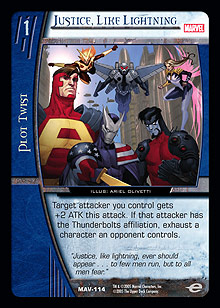 Taking the name Citizen V (which, ironically, was the same as a German war hero who was killed decades earlier by Zemo’s own father), Zemo put the team through a short period of hyper-intensive training, so that the members could get used to working together and to make sure everyone was ready for their foray into the new world of crime-fighting. They were called the Thunderbolts—a name that suited Zemo’s ideals, but sounded heroic and identifiable. Their motto was Justice, Like Lightning, famous words by Thomas Randolph that are quoted in the card’s flavor text.
Taking the name Citizen V (which, ironically, was the same as a German war hero who was killed decades earlier by Zemo’s own father), Zemo put the team through a short period of hyper-intensive training, so that the members could get used to working together and to make sure everyone was ready for their foray into the new world of crime-fighting. They were called the Thunderbolts—a name that suited Zemo’s ideals, but sounded heroic and identifiable. Their motto was Justice, Like Lightning, famous words by Thomas Randolph that are quoted in the card’s flavor text.
Things went splendidly for the Thunderbolts, and they were completely convincing to an unknowing public. In fact, when Jolt joined the ranks of the team, she believed that they were truly a team of heroes. They fought The Wrecking Crew, Circus of Crime, the Elements of Doom (a team that would become one of their greatest nemeses), and the latest incarnation of the Masters of Evil, led by the new, new Crimson Cowl. This was a foe that particularly irked Zemo, as he couldn’t reveal that his team was truly the Masters of Evil and he couldn’t steal control of the team from the Crimson Cowl without giving away his secret.
However, that all became moot when the Avengers and Fantastic Four came back in the Heroes Return storyline. The Thunderbolts had already suffered one major dramatic setback, of a sort, when Techno had his neck broken by Iron of the Elements of Doom. Techno was forced to upload his consciousness into an android body (as his Man of Metal version displays), and would fight on in that form.
When the real heroes returned, Zemo got nervous, since his heroes were enjoying their heroics a little too much. He leaked their secret identities to SHIELD to try and keep it in line, revealing their true Faces of Evil. But Zemo’s plan backfired and his team turned on him. The seeds of betrayal sowed by Meteorite took hold, and aside from Techno, Zemo had no allies. At Zemo’s behest, Techno used an invention to force the Avengers and Fantastic Four to fight their former allies—but the Thunderbolts were triumphant and broke the heroes free from their mental bonds.
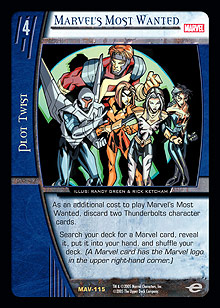 Meteorite became Moonstone once again, taking temporary lead of the team. She tried to nab Zemo, but he was aided in escaping by Atlas, who still felt indebted to Zemo for his life. Techno got away as well, and the team decided to turn themselves in—but they never made it. They disappeared to the Kosmos dimension, where they fought in a pan-dimensional revolution, while back on Earth they became Marvel’s Most Wanted villains. Additionally, Dallas Riordan, who was the liaison between the team and the mayor’s office in New York (and romantically involved with Atlas), lost her job and almost went to trial as an accessory.
Meteorite became Moonstone once again, taking temporary lead of the team. She tried to nab Zemo, but he was aided in escaping by Atlas, who still felt indebted to Zemo for his life. Techno got away as well, and the team decided to turn themselves in—but they never made it. They disappeared to the Kosmos dimension, where they fought in a pan-dimensional revolution, while back on Earth they became Marvel’s Most Wanted villains. Additionally, Dallas Riordan, who was the liaison between the team and the mayor’s office in New York (and romantically involved with Atlas), lost her job and almost went to trial as an accessory.
When the Thunderbolts returned, they had to hide from capture, though they did manage to take in one new member.
Charcoal was a teenager who was a part of Arnim Zola’s Imperial Forces, and wanted to redeem himself, just as the Thunderbolts were trying to do. They did receive
A Second Chance when Hawkeye offered to lead the team in their quest to become true heroes. He even got them a governmental pardon in return for Abner Jenkins (MACH-1) turning himself in to the authorities for a murder that he had previously committed as the Beetle. Everyone agreed on this plan, and Abner began serving his sentence while Hawkeye took over the leader’s mantle.
Meanwhile, the android Techno took the place of the team’s weaponsmith, Ogre, so that he could infiltrate the team. He broke Jenkins out of prison, and changed his appearance and armor to give him a New Identity—that of Matthew Davis or MACH-2. While this was happening, the mysterious reappearance of the Scourge, who was either Jack Monroe or Nomad and under various levels of mind control, was eliminating Thunderbolts members. He took out Jolt, ex-Thunderbolt Baron Zemo and the android Techno, though all three would actually survive. It took the combined efforts of the Thunderbolts and the SHIELD-sponsored Redeemers (who included the now-healed original Techno, who called himself the Fixer again) to take them down. And, if that wasn’t bad enough, Atlas had a power meltdown and supposedly died at this point.
THE END OF THE THUNDERBOLTS?
Here’s where it gets complicated, so bear with me. The team cut a deal with the government, disbanding the team in return for a complete presidential pardon for MACH-1, Songbird, Moonstone and the ‘late’ Atlas. In exchange, these characters weren’t allowed to use their powers. On the other hand, Hawkeye was sent to prison. Jolt and Charcoal ended up in the Redeemers, where Charcoal would be killed by Graviton at Mt.Charteris. Graviton took out most of the Redeemers and was only defeated by a reformed Thunderbolts team of Citizen V, the true Fixer, Jolt, Abe Jenkins (now as MACH-3), Moonstone, and Atlas, who had been inhabiting Dallas Riordan’s body. The team then journeyed to the dimension where the Heroes Reborn storyline took place and stayed there for a while.
Meanwhile, back on Earth, Hawkeye busted out of prison with Plantman, Cottonmouth, and Mentallo. Songbird, now working for SHIELD, was sent to hunt them down. She caught up to them just as they uncovered a plot by the Crimson Cowl and the latest Masters of Evil, involving several super villains and a controlling biotoxin. Enter a second team of Thunderbolts, as the first “team” is still in the other dimension. Led by Hawkeye, we have Songbird, Plantman (now known as Blackheath), Cardinal (also known as Harrier), Cyclone, Gypsy Moth (also known as Skein), and Man-Killer (or Amazon). Cyclone would be the lone betrayer, and this incarnation of the Thunderbolts would eventually take down the Masters of Evil.
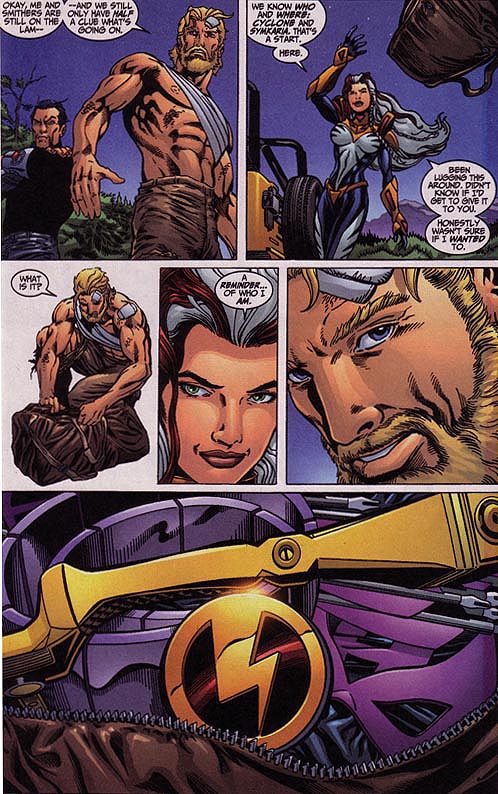
This is when the original team returned to their proper Earth, creating a giant team to sort through. Amazon and Skein took their leave. Mach-3 and Harrier returned to prison—voluntarily, I might add, as Abe particularly wished to repay his debt to society. Jolt stayed in the other dimension, where she joined the Young Allies. Dallas and Atlas were separated once again, with Dallas discovering that she suddenly had his super-powers, and she became Vantage. Fixer restored Atlas’s powers to him as well. Zemo convinced Hawkeye to let him lead the team, as he “truly wanted to do right this time.” Yeah, right.
Now, we had a team of Baron
Zemo leading Atlas, Blackheath, Fixer, Moonstone, Dallas Riordan, and Songbird, and we began Project Liberator, another Deadly Conspiracy of Zemo’s to fix the world. This time, the plan is to eliminate all super powers but those of the Thunderbolts, thereby allowing the Thunderbolts to rule the world. This would ensure that law and order prevailed with the Thunderbolts as super-powered servants of “justice.”
The Avengers, who were understandably concerned, sent Iron Man into the Thunderbolts clubhouse in the guise of Cobalt Man, so that he could ferret out the secrets of their plan. With Abe’s help from prison, the Avengers moved in, and, much to Hawkeye’s chagrin, were forced to fight the Thunderbolts. They were finally able to destroy the Liberator device, albeit at the expense of Moonstone, who was turned into a powerless vegetable. Zemo would escape again, and Blackheath, having lost his powers as well, headed back to prison.
But Jenkins was on his way out, receiving pardon for his help, and decided to form . . .
THE NEW THUNDERBOLTS
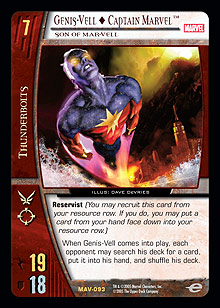 Abe Jenkins, always the idealist, decided that they really should be heroes and that the Thunderbolts could do good. The core team was Jenkins in a new MACH-4 suit, Songbird, Atlas (minus Dallas, who went to work for Homeland Security) and some new members. These new members included Blizzard, who, like Jenkins at the beginning of the Thunderbolts, just wanted to do some good and turn his life around. Speed Demon was in it for the ride and Radioactive Man was there as much as an agent of the Chinese government as anything else, though he was trying to do some good. Genis-Vell, the new Captain Marvel, was there because he had a crush on Songbird. Joystick also joined the team early on after a spectacular fight against the Atlantean renegade terrorists, the Fathom 5 and the Wrecking Crew.
Abe Jenkins, always the idealist, decided that they really should be heroes and that the Thunderbolts could do good. The core team was Jenkins in a new MACH-4 suit, Songbird, Atlas (minus Dallas, who went to work for Homeland Security) and some new members. These new members included Blizzard, who, like Jenkins at the beginning of the Thunderbolts, just wanted to do some good and turn his life around. Speed Demon was in it for the ride and Radioactive Man was there as much as an agent of the Chinese government as anything else, though he was trying to do some good. Genis-Vell, the new Captain Marvel, was there because he had a crush on Songbird. Joystick also joined the team early on after a spectacular fight against the Atlantean renegade terrorists, the Fathom 5 and the Wrecking Crew.
The friction in the team started early, as Atlas, who vehemently disliked Genis, sucker-punched him and toss him into the ocean. Genis survived and called himself Photon—eventually spurring a visit from Miss Monica Rambeau, who accused him of repeatedly stealing her nickname.
When Baron Von Strucker led a Hydra invasion of New York, the team would discover that Abe had funded the Thunderbolts revival with money from Strucker’s organization. Even though Abe (in his original Beetle armor when his MACH-4 armor encountered some difficulties) led the team to defeat the Hydra invaders, it wasn’t enough to keep Songbird from leaving both Abe and the team, since she felt betrayed by his use of dirty money when they’re all trying to start over.
Songbird’s vocal cords were already strained from an earlier battle, so she headed back to college. She became an easy target for the Purple Man, who was apparently still alive—even though he was supposedly killed a couple of times in the last few years. (Heck, he’s been dead almost as often as Magneto.) The Thunderbolts are currently in the middle of a tango with the Swordsman (who has just skewered Abe) and the Purple Man, who’s controlling Melissa.
THE THUNDERBOLTS, IN A NUTSHELL
Here’s a continuity rundown of some of the Thunderbolts characters, and what their game text means in terms of their characters.
The Reluctant Hero version of Beetle reflects how Abe slowly began to become more interested in the heroic life, as he realized how much more rewarding it was than a life of crime. Being a part of a team affected him very much, so much so that he’ll willingly sacrifice himself in order to preserve his teammates and their cause by finding the team-up card to keep them together. These are sentiments that would grow within him and have helped him adjust to his more recent role as team leader.
His Matthew Davis version is from when he changed identities to hide the fact that he had broken out of prison. He gets a late-game boost as a result of Techno’s tinkering, just as Techno himself boosts smaller characters when he has the resources available. The two combined make the boost really impressive.
Finally, his repentant Villain version shows a man torn up inside. On the one hand, he has 12 ATK and 10 DEF, huge stats for a 5-drop that show his resolve to repay his debts to society—but on the other hand, the conflict he feels inside is apparent, as his opponents get an invulnerable combat against him. Finally, his New Team Leader character, with his strongest armor yet, shows how even though the team is rough about the edges, he manages to lead them through trouble, and his will to be a good leader and make something of himself and his ragtag team strengthens.
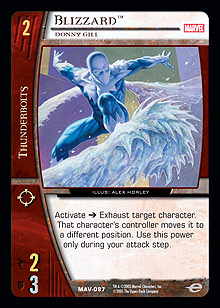 Blizzard is interesting, because he not only has the typical “freeze” power of exhaustion, but also moves that character to a different position, as they try and escape the cold.
Blizzard is interesting, because he not only has the typical “freeze” power of exhaustion, but also moves that character to a different position, as they try and escape the cold.
Atlas’s Ionic Powerhouse version is from when his powers began to become out of control, getting more and more powerful until they pretty much overload him. The more you pay, the bigger he gets. Kosmos Convict is an earlier Atlas, when he was a prisoner in the Kosmos dimension. He just got tougher and angrier, which is reflected in his effect giving him a yummy power bonus every turn.
Hawkeye, a man who never passes up a challenge and can back up his braggadocio with action after action, spurs his teammates onwards, giving them a stun-free attack when attacking a bigger brute. This is especially useful in a team attack, which is where Hawkeye’s Thunderbolts really shone.
Citizen V’s Tactician version is from when Helmut Zemo put the team together as pretend-heroes. Treating every teammate a chess piece, those teammates get an ATK bonus for being in the proper position at his side. Warmonger is Helmut Zemo in the other dimension, trying to rule it and recruiting as many characters to his cause as possible. Hence, he gives others the Thunderbolts affiliation, and an ATK bonus for beating ‘em when they’re down.
Cobalt Man is a double agent, so he gets double loyalty. He also has the power of Iron Man wrapped up in Cobalt Man’s “containment suit,” hence the huge ATK value and the invulnerable attack.
The Twin Moonstones version of Meteorite, an 8-drop of immense power, is from when she stole a second Moonstone from her counter version on the Heroes Reborn Earth. Her drawback represents he twisted mind and lust for personal gain. She wasn’t a team player, and so in order to win, you have to defeat her as well as your opponent.
Songbird’s Sonic Carapace is the version that uses the special harness that Techno fixed up for her. She has an immense ATK, but she shakes up your opponent’s resources as well, giving them a second use of a resource once per turn. Her Heroine Unbound version showcases her at her peak, re-readying in preparation for anything, even after attacking.
The Gadgeteer version of Techno reflects his ingenuity. Its discard effect shows Ebersol, when he has the resources available, giving a weaker teammate the key to victory: in this case, it’s a +2 ATK/+2 DEF power increase. His Man of Metal version reflects his technological knowledge, allowing you to repair and reuse a previously expended card—but at the expense of allowing your opponent the same advantage. This reflects that this version is only a copy of his true self, and therefore doesn’t quite have the same level of ingenuity as his true self.
Radioactive Man’s ability displays his radioactive energy. Just as he did in Atlantis, he can give someone radiation sickness. Unless he’s expended energy by attacking or exhausting, even if he’s taken out, someone’s probably going down with him.
Finally, Speed Demon, like his other version, has the ability to re-ready. But this stronger and smarter version can attack again. If he’s survived a couple of turns, he’s almost guaranteed a second attack, as he won’t be stunned during the attack.
NEXT WEEK: It’s Indy time again!
Questions? Queries? Comments? Send ‘em along and I’ll try to get them answered in the column! Email me at:
Kergillian (at) hotmail (dot) com
*You may recognize this scene from the Finishing Move card—and if that’s not enough to KO a stunned character, I don’t know what is!
Also known by his screen name Kergillian, Ben Kalman has been involved in the Vs. community since day one. He started the first major online community, the Vs. Listserv, through Yahoo! Groups, and it now boasts well over 1,750 members! For more on the Yahoo! group, go to http://groups.yahoo.com/group/Marvel_DC_TCG.